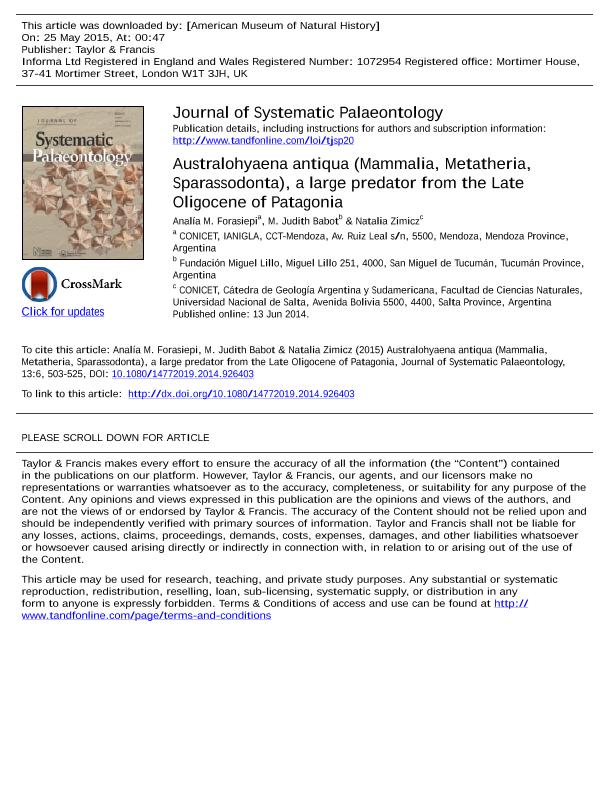Artículo
Australohyaena antiqua (Mammalia, Metatheria, Sparassodonta), a large predator from the Late Oligocene of Patagonia
Fecha de publicación:
05/2015
Editorial:
Cambridge University Press
Revista:
Journal of Systematic Palaeontology
ISSN:
1477-2019
Idioma:
Inglés
Tipo de recurso:
Artículo publicado
Clasificación temática:
Resumen
An almost complete skull of Australohyaena antiqua (Ameghino), from the Late Oligocene (Deseadan SALMA) of Cabeza Blanca, Chubut Province, Argentina is described and analysed. For more than a century, this species was represented by isolated teeth. The genus Australohyaena gen. nov. is proposed based on a phylogenetic reconstruction that demonstrates that A. antiqua is a Borhyaenidae (Mammalia, Sparassodonta), grouped with Arctodictis and Borhyaena, but not with Pharsophorus lacerans, the genus to which antiqua was formerly assigned. A. antiqua is recognized by several features on the skull, dentary and dentition. In addition, a short snout, large canines, deep jaw, reduced protocone and talonid determine A. antiqua as hypercarnivorous. A vaulted skull, well-developed temporal fossa and little difference on the jaw depth at p3 and m4, are suggestive of bone-cracker specializations. A. antiqua is within the largest Deseadan sparassodonts with a body mass of about 70 kg. Homoplasies are detected within borhyaenoids on lower molar cusps. The metaconid is lost within Sparassodonta, although Pharsophorus and borhyaenids retained the metaconid on m2-m4 or m2-m3.
Palabras clave:
Anatomy
,
Cenozoic
,
Palaeoecology
,
Phylogeny
,
South America
,
Stem Marsupialia
Archivos asociados
Licencia
Identificadores
Colecciones
Articulos(IANIGLA)
Articulos de INST. ARG. DE NIVOLOGIA, GLACIOLOGIA Y CS. AMBIENT
Articulos de INST. ARG. DE NIVOLOGIA, GLACIOLOGIA Y CS. AMBIENT
Citación
Forasiepi, Analia Marta; Babot, María Judith; Zimicz, Ana Natalia; Australohyaena antiqua (Mammalia, Metatheria, Sparassodonta), a large predator from the Late Oligocene of Patagonia; Cambridge University Press; Journal of Systematic Palaeontology; 13; 6; 5-2015; 503-525
Compartir
Altmétricas




